MICROSCOPE-ANTIQUES.COM © 2013-15.
'STATIV Vb MICROSCOPE':
c. 1904-1924
Maker: Paul Waechter
Serial Number: None
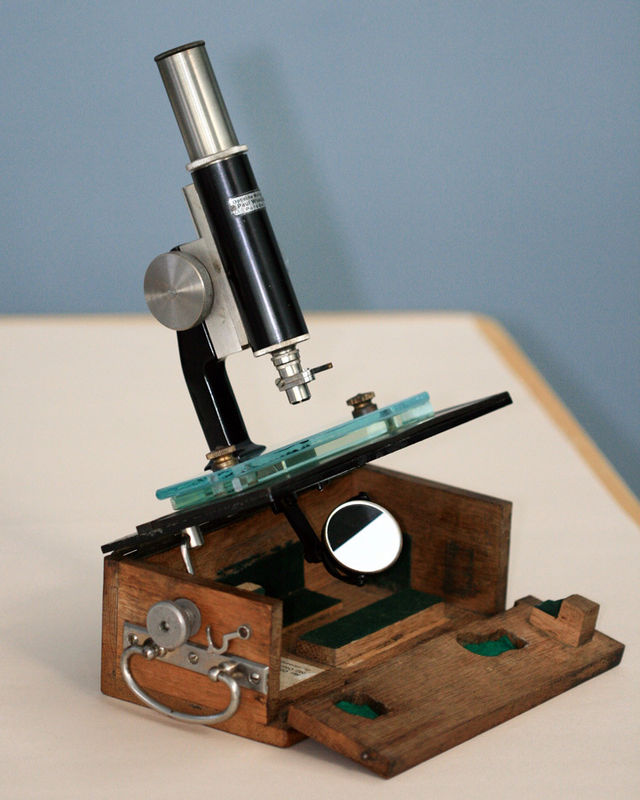
DESCRIPTION
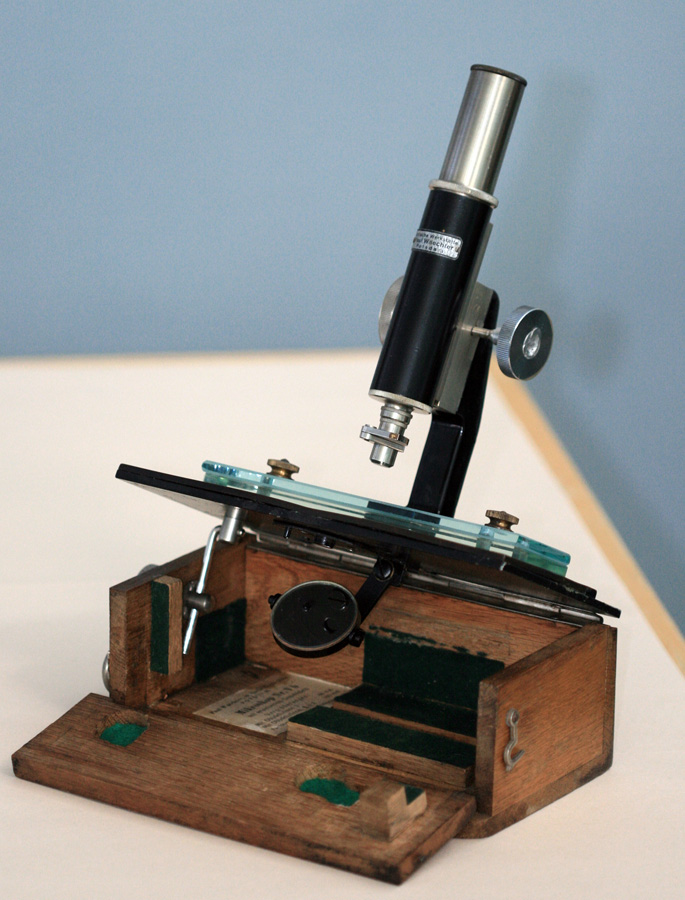
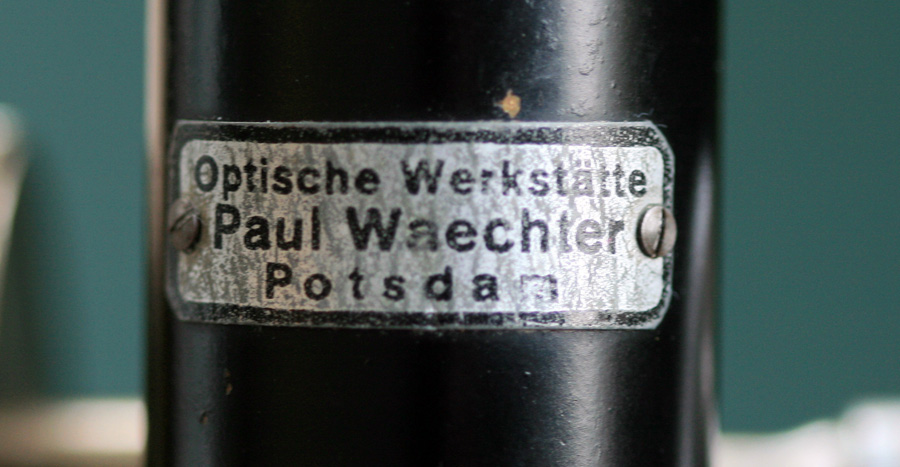
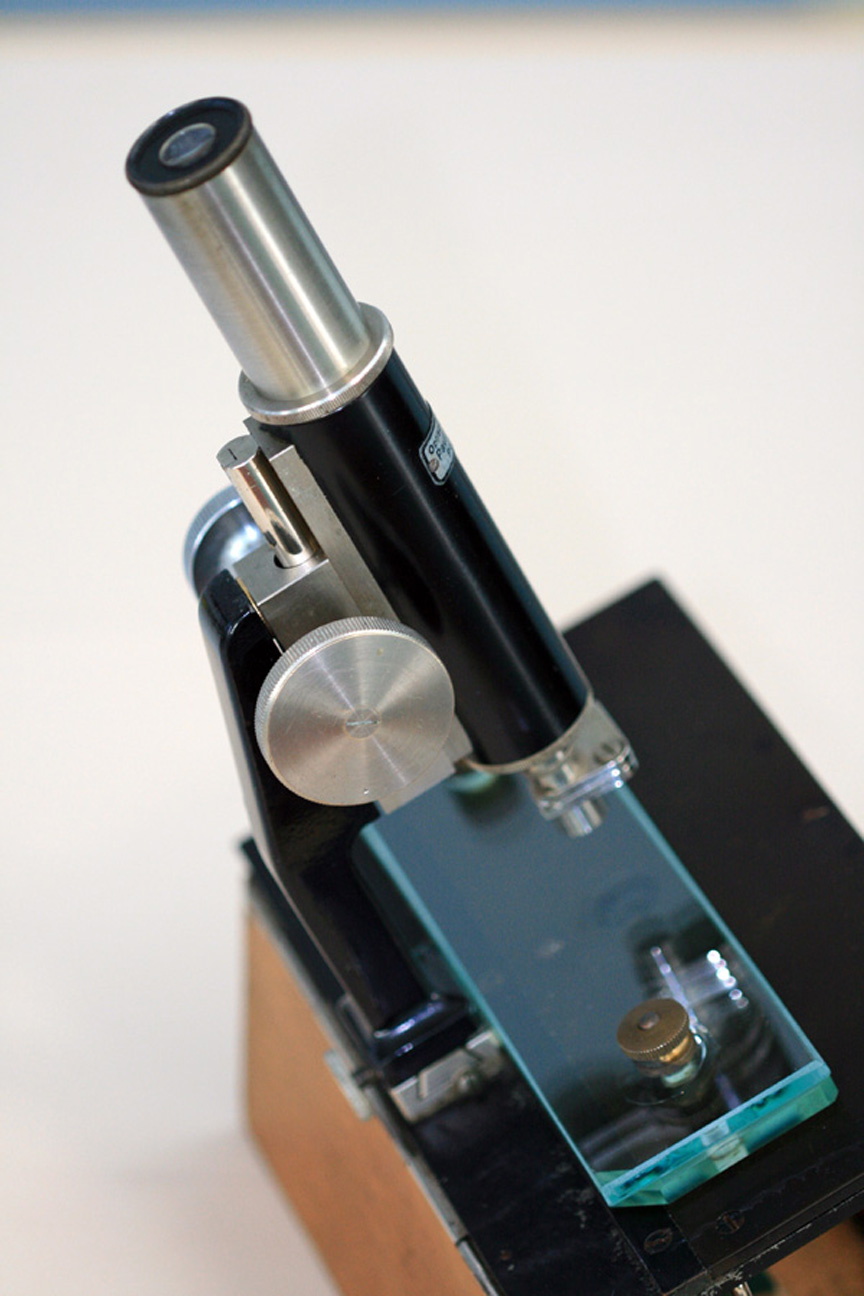
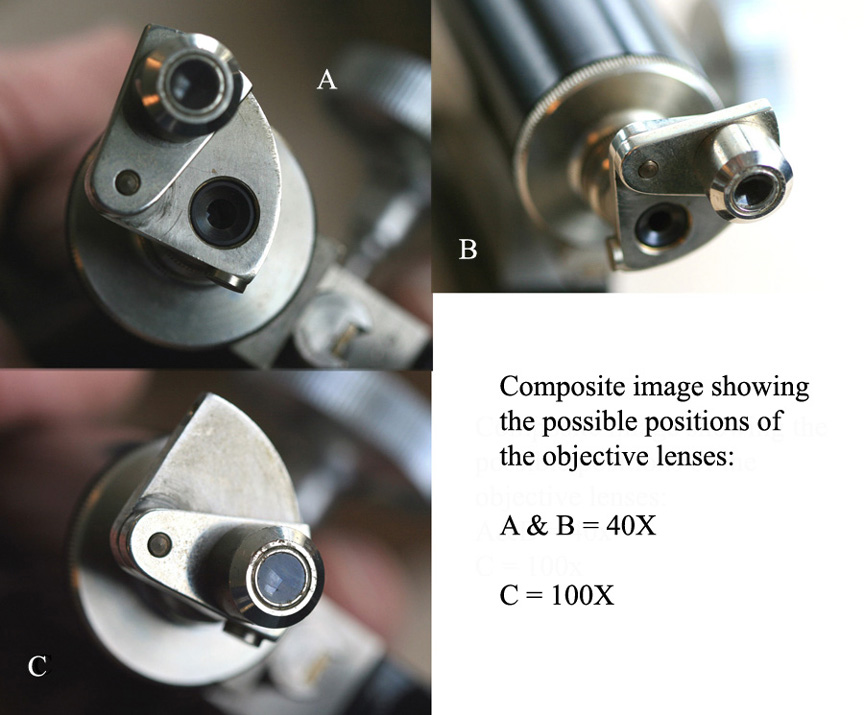

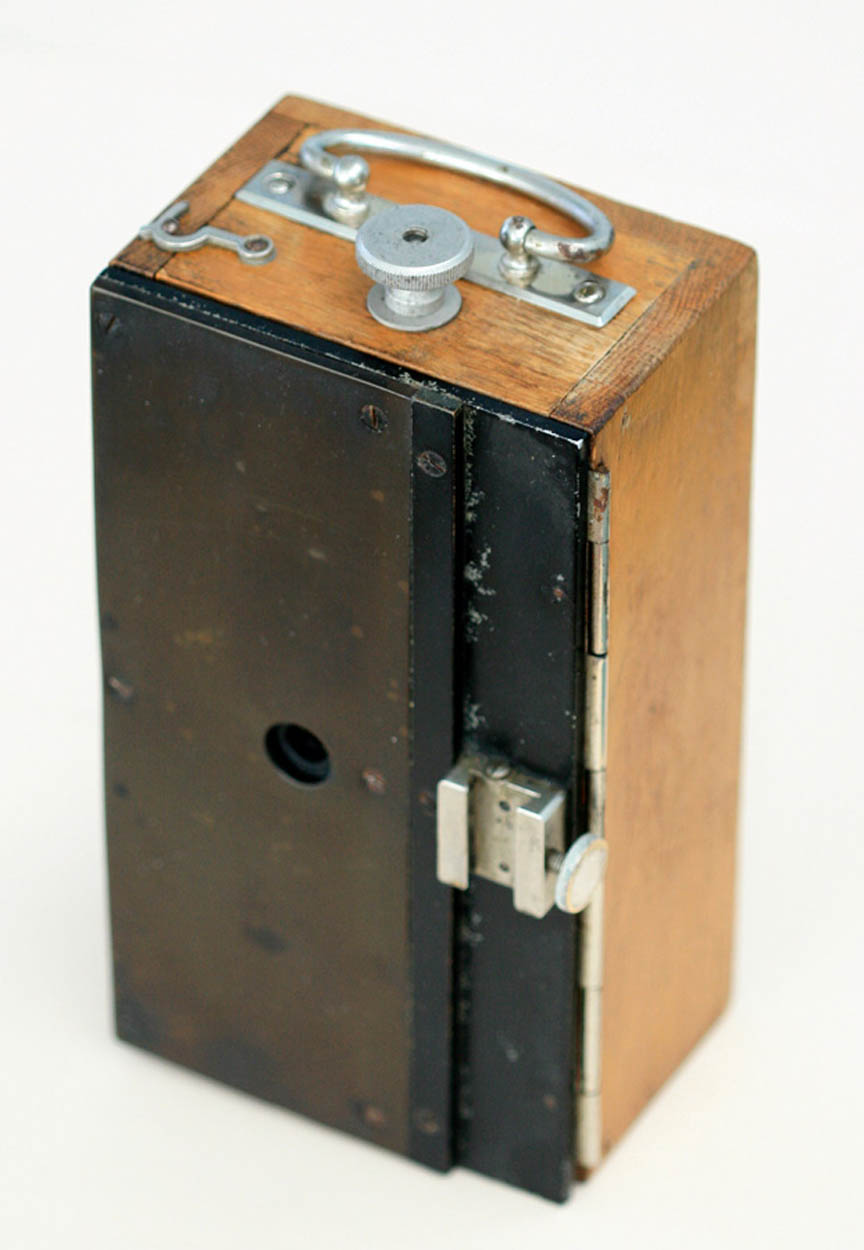
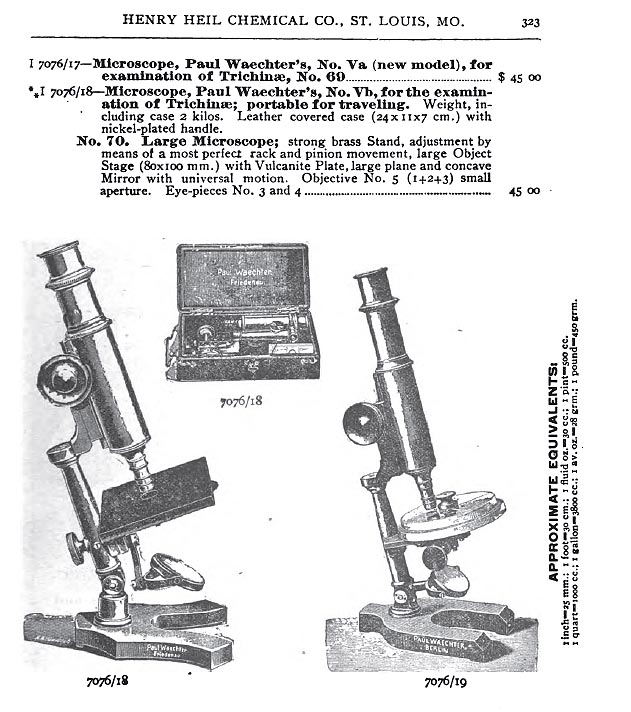
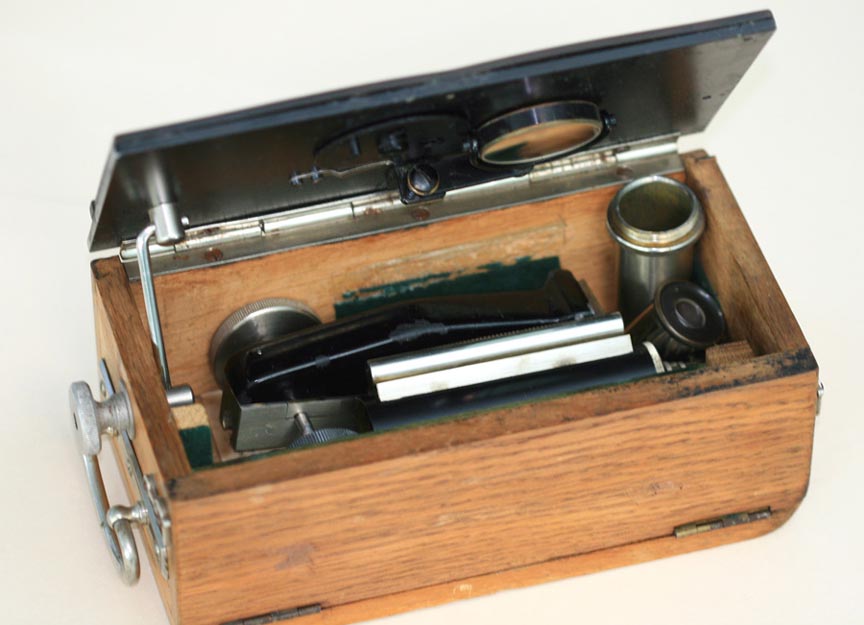
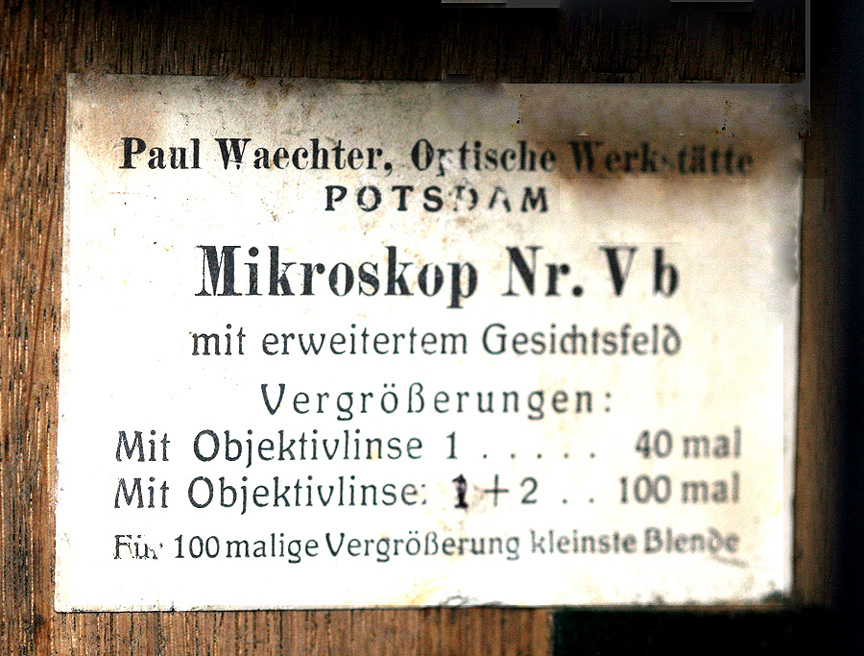 I am grateful to Bill Burnett for furnishing part of this description and many of the images. Paul Waechter Stativ Vb (Stand Vb) Portable Meat Inspector’s Case Mounted Microscope or Trichinoscope (In German: 'Trichinoskop' or 'Trichinen Mikroskop') with integral wood case and accessories. The microscope can be broken down into several components and is fully contained within a wood case. The exterior dimensions of the wood case are 8¼-inches wide by 3-inches high by 4½-inches deep. The lid of the case is made of metal atop of which is a vulcanite rubber stage plate with a central aperture through the lid. The case lid is unlocked by turning a screw mechanism at the side of the case, which allows the lid to open. The front wood panel of the case can then be opened by releasing hook and pin clasps found on either side of the case thereby providing full access to the contents of the case. The limb and body tube of this microscope are designed to be mounted atop the wood case. At the center of the back of the case lid is a female dovetail fitting. At the base of the microscope limb is a corresponding male dovetail that slides into the receptacle on the case. Once the limb with the body tube is inserted into this fitting, it is locked into place with a setscrew found at the back of the dovetail mount. The metal top of the case with its vulcanite stage plate conveniently forms the microscope stage. Case lid-stage can be tilted to various angles from the horizontal and held in place with the lock knob on the side of the case. Stage includes a center aperture, Under the case lid is a 40mm diameter plano-concave mirror on an articulating mirror bar. The compressor or compressorium consists of two thick pieces of glass, each about 6.5 mm thick that screw together to form a compressor that measures about 171.5 mm (6.75 inches) by 51 mm (2 inches). The last image shows an ad from about 1904 depicting this microscope in the middle.
I am grateful to Bill Burnett for furnishing part of this description and many of the images. Paul Waechter Stativ Vb (Stand Vb) Portable Meat Inspector’s Case Mounted Microscope or Trichinoscope (In German: 'Trichinoskop' or 'Trichinen Mikroskop') with integral wood case and accessories. The microscope can be broken down into several components and is fully contained within a wood case. The exterior dimensions of the wood case are 8¼-inches wide by 3-inches high by 4½-inches deep. The lid of the case is made of metal atop of which is a vulcanite rubber stage plate with a central aperture through the lid. The case lid is unlocked by turning a screw mechanism at the side of the case, which allows the lid to open. The front wood panel of the case can then be opened by releasing hook and pin clasps found on either side of the case thereby providing full access to the contents of the case. The limb and body tube of this microscope are designed to be mounted atop the wood case. At the center of the back of the case lid is a female dovetail fitting. At the base of the microscope limb is a corresponding male dovetail that slides into the receptacle on the case. Once the limb with the body tube is inserted into this fitting, it is locked into place with a setscrew found at the back of the dovetail mount. The metal top of the case with its vulcanite stage plate conveniently forms the microscope stage. Case lid-stage can be tilted to various angles from the horizontal and held in place with the lock knob on the side of the case. Stage includes a center aperture, Under the case lid is a 40mm diameter plano-concave mirror on an articulating mirror bar. The compressor or compressorium consists of two thick pieces of glass, each about 6.5 mm thick that screw together to form a compressor that measures about 171.5 mm (6.75 inches) by 51 mm (2 inches). The last image shows an ad from about 1904 depicting this microscope in the middle.
HISTORY OF THE PAUL WAECHTER MICROSCOPES
I provide some of this information through the kindness of Bill Burnett.
Paul Waechter (1846 - 1893) was trained to be an optician and mechanic at the famous Zeiss Optical Workshop in Jena, Germany. In 1872, Waechter founded his own optical workshop at Köpnicker Strasse No. 115 in Berlin. In the year 1886, Waechter published advertisements for his microscopes in the scientific literature that included the phrase, “Student of Dr. Zeiss.” His earlier instruments were signed in script on the body tube either, “Paul Waechter in Berlin” or more simply, “Paul Waechter, Berlin.”
By the year 1890, demand for his microscopes had increased to such and extent that he moved his workshop to larger facilities in Friedenau, Berlin, first at Albe Strasse 21 and then at Nied Strasse 19. The company remained at Friedenau on into the early years of the 20th Century. At this time, the business was named “Optische Werkstaette Paul Waechter.” Microscopes produced by the company during this period often did not bear a signature or serial number on the microscope itself, but these items were reserved for the wood case that normally accompanied the instrument. The serial number of the instrument was customarily stamped on the lip of the case and inside the lid of the case was a paper label bearing the name of the manufacturer as Waechter along with a magnification table. This was a practice not only of Weachter but of Scheick and even Bausch & Lomb in the U.S.A. B & L often place the serial number on the wooden floor of their microscope cases.
Between the years 1872 and 1892, Waechter produced over 20,000 microscopes, mostly for the examination of trichinae in meat. It was the famous scientist, Rudolph Virchow (1821 – 1902) who, in circa 1870, succeeded in inducing various German states to make compulsory the testing of pork for Trichinosis in abattoirs (slaughter houses). For more about trichinosis, see the section on history on the web page on the Schieck Trichenin Mikroskop). Waechter and several other German microscope manufacturers designed and produced microscopes especially to meet this need. Many of these instruments were exported outside of Europe including to the USA.
After the death of Waechter in 1893, his longtime assistant, directed the company. Later, a partnership continued operations of the business on into the early years of the 20th Century. By the mid-1930s, the business was moved from Berlin to Potsdam in what is now the nation of Poland (formerly the German State of Prussia). After that, the firm apparently no longer made microscopes.
I would like to thank Bill Burnett, who originally sold me this instrument, for his kindness in allowing me to use his photographs of it and also initially pointing out some of the facts pertinent to its history which is also included with additional information here, and was confirmed by other sources.










 I am grateful to Bill Burnett for furnishing part of this description and many of the images. Paul Waechter Stativ Vb (Stand Vb) Portable Meat Inspector’s Case Mounted Microscope or Trichinoscope (In German: 'Trichinoskop' or 'Trichinen Mikroskop') with integral wood case and accessories. The microscope can be broken down into several components and is fully contained within a wood case. The exterior dimensions of the wood case are 8¼-inches wide by 3-inches high by 4½-inches deep. The lid of the case is made of metal atop of which is a vulcanite rubber stage plate with a central aperture through the lid. The case lid is unlocked by turning a screw mechanism at the side of the case, which allows the lid to open. The front wood panel of the case can then be opened by releasing hook and pin clasps found on either side of the case thereby providing full access to the contents of the case. The limb and body tube of this microscope are designed to be mounted atop the wood case. At the center of the back of the case lid is a female dovetail fitting. At the base of the microscope limb is a corresponding male dovetail that slides into the receptacle on the case. Once the limb with the body tube is inserted into this fitting, it is locked into place with a setscrew found at the back of the dovetail mount. The metal top of the case with its vulcanite stage plate conveniently forms the microscope stage. Case lid-stage can be tilted to various angles from the horizontal and held in place with the lock knob on the side of the case. Stage includes a center aperture, Under the case lid is a 40mm diameter plano-concave mirror on an articulating mirror bar. The compressor or compressorium consists of two thick pieces of glass, each about 6.5 mm thick that screw together to form a compressor that measures about 171.5 mm (6.75 inches) by 51 mm (2 inches). The last image shows an ad from about 1904 depicting this microscope in the middle.
I am grateful to Bill Burnett for furnishing part of this description and many of the images. Paul Waechter Stativ Vb (Stand Vb) Portable Meat Inspector’s Case Mounted Microscope or Trichinoscope (In German: 'Trichinoskop' or 'Trichinen Mikroskop') with integral wood case and accessories. The microscope can be broken down into several components and is fully contained within a wood case. The exterior dimensions of the wood case are 8¼-inches wide by 3-inches high by 4½-inches deep. The lid of the case is made of metal atop of which is a vulcanite rubber stage plate with a central aperture through the lid. The case lid is unlocked by turning a screw mechanism at the side of the case, which allows the lid to open. The front wood panel of the case can then be opened by releasing hook and pin clasps found on either side of the case thereby providing full access to the contents of the case. The limb and body tube of this microscope are designed to be mounted atop the wood case. At the center of the back of the case lid is a female dovetail fitting. At the base of the microscope limb is a corresponding male dovetail that slides into the receptacle on the case. Once the limb with the body tube is inserted into this fitting, it is locked into place with a setscrew found at the back of the dovetail mount. The metal top of the case with its vulcanite stage plate conveniently forms the microscope stage. Case lid-stage can be tilted to various angles from the horizontal and held in place with the lock knob on the side of the case. Stage includes a center aperture, Under the case lid is a 40mm diameter plano-concave mirror on an articulating mirror bar. The compressor or compressorium consists of two thick pieces of glass, each about 6.5 mm thick that screw together to form a compressor that measures about 171.5 mm (6.75 inches) by 51 mm (2 inches). The last image shows an ad from about 1904 depicting this microscope in the middle.